Audi 2012 Annual Report Download - page 219
Download and view the complete annual report
Please find page 219 of the 2012 Audi annual report below. You can navigate through the pages in the report by either clicking on the pages listed below, or by using the keyword search tool below to find specific information within the annual report.-
 1
1 -
 2
2 -
 3
3 -
 4
4 -
 5
5 -
 6
6 -
 7
7 -
 8
8 -
 9
9 -
 10
10 -
 11
11 -
 12
12 -
 13
13 -
 14
14 -
 15
15 -
 16
16 -
 17
17 -
 18
18 -
 19
19 -
 20
20 -
 21
21 -
 22
22 -
 23
23 -
 24
24 -
 25
25 -
 26
26 -
 27
27 -
 28
28 -
 29
29 -
 30
30 -
 31
31 -
 32
32 -
 33
33 -
 34
34 -
 35
35 -
 36
36 -
 37
37 -
 38
38 -
 39
39 -
 40
40 -
 41
41 -
 42
42 -
 43
43 -
 44
44 -
 45
45 -
 46
46 -
 47
47 -
 48
48 -
 49
49 -
 50
50 -
 51
51 -
 52
52 -
 53
53 -
 54
54 -
 55
55 -
 56
56 -
 57
57 -
 58
58 -
 59
59 -
 60
60 -
 61
61 -
 62
62 -
 63
63 -
 64
64 -
 65
65 -
 66
66 -
 67
67 -
 68
68 -
 69
69 -
 70
70 -
 71
71 -
 72
72 -
 73
73 -
 74
74 -
 75
75 -
 76
76 -
 77
77 -
 78
78 -
 79
79 -
 80
80 -
 81
81 -
 82
82 -
 83
83 -
 84
84 -
 85
85 -
 86
86 -
 87
87 -
 88
88 -
 89
89 -
 90
90 -
 91
91 -
 92
92 -
 93
93 -
 94
94 -
 95
95 -
 96
96 -
 97
97 -
 98
98 -
 99
99 -
 100
100 -
 101
101 -
 102
102 -
 103
103 -
 104
104 -
 105
105 -
 106
106 -
 107
107 -
 108
108 -
 109
109 -
 110
110 -
 111
111 -
 112
112 -
 113
113 -
 114
114 -
 115
115 -
 116
116 -
 117
117 -
 118
118 -
 119
119 -
 120
120 -
 121
121 -
 122
122 -
 123
123 -
 124
124 -
 125
125 -
 126
126 -
 127
127 -
 128
128 -
 129
129 -
 130
130 -
 131
131 -
 132
132 -
 133
133 -
 134
134 -
 135
135 -
 136
136 -
 137
137 -
 138
138 -
 139
139 -
 140
140 -
 141
141 -
 142
142 -
 143
143 -
 144
144 -
 145
145 -
 146
146 -
 147
147 -
 148
148 -
 149
149 -
 150
150 -
 151
151 -
 152
152 -
 153
153 -
 154
154 -
 155
155 -
 156
156 -
 157
157 -
 158
158 -
 159
159 -
 160
160 -
 161
161 -
 162
162 -
 163
163 -
 164
164 -
 165
165 -
 166
166 -
 167
167 -
 168
168 -
 169
169 -
 170
170 -
 171
171 -
 172
172 -
 173
173 -
 174
174 -
 175
175 -
 176
176 -
 177
177 -
 178
178 -
 179
179 -
 180
180 -
 181
181 -
 182
182 -
 183
183 -
 184
184 -
 185
185 -
 186
186 -
 187
187 -
 188
188 -
 189
189 -
 190
190 -
 191
191 -
 192
192 -
 193
193 -
 194
194 -
 195
195 -
 196
196 -
 197
197 -
 198
198 -
 199
199 -
 200
200 -
 201
201 -
 202
202 -
 203
203 -
 204
204 -
 205
205 -
 206
206 -
 207
207 -
 208
208 -
 209
209 -
 210
210 -
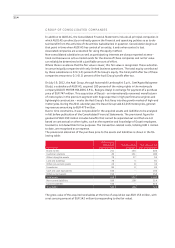 211
211 -
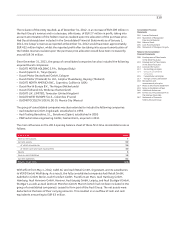 212
212 -
 213
213 -
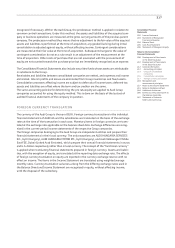 214
214 -
 215
215 -
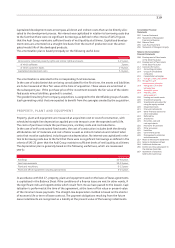 216
216 -
 217
217 -
 218
218 -
 219
219 -
 220
220 -
 221
221 -
 222
222 -
 223
223 -
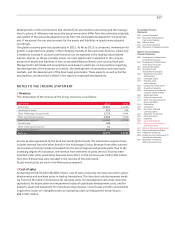 224
224 -
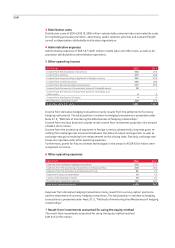 225
225 -
 226
226 -
 227
227 -
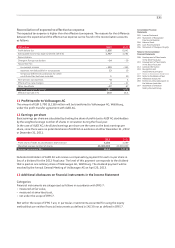 228
228 -
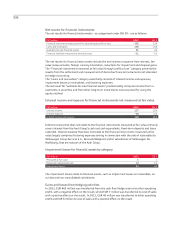 229
229 -
 230
230 -
 231
231 -
 232
232 -
 233
233 -
 234
234 -
 235
235 -
 236
236 -
 237
237 -
 238
238 -
 239
239 -
 240
240 -
 241
241 -
 242
242 -
 243
243 -
 244
244 -
 245
245 -
 246
246 -
 247
247 -
 248
248 -
 249
249 -
 250
250 -
 251
251 -
 252
252 -
 253
253 -
 254
254 -
 255
255 -
 256
256 -
 257
257 -
 258
258 -
 259
259 -
 260
260 -
 261
261 -
 262
262 -
 263
263 -
 264
264 -
 265
265 -
 266
266 -
 267
267 -
 268
268 -
 269
269 -
 270
270 -
 271
271 -
 272
272 -
 273
273 -
 274
274 -
 275
275 -
 276
276 -
 277
277 -
 278
278 -
 279
279 -
 280
280 -
 281
281 -
 282
282 -
 283
283 -
 284
284 -
 285
285
 |
 |

222
In the case of current financial assets and liabilities, the amortized cost basically corresponds to
the nominal value or the repayment value.
Fair value generally corresponds to the market value or trading price. If no active market exists,
fair value is determined using investment mathematics methods, for example by discounting
future cash flows at the market rate or applying established option pricing models.
Financial instruments are abandoned if the rights to payments from the investment have expired
or been transferred and the Audi Group has substantially transferred all risks and opportunities
associated with their title.
In the case of factoring in the Audi Group, all of the essential opportunities and risks are trans-
ferred, leaving no continuing involvement.
Financial assets and liabilities include both non-derivative and derivative claims or commit-
ments, as detailed below.
Non-derivative financial instruments
The “Loans and receivables” and “Financial liabilities measured at amortized cost” categories
include non-derivative financial instruments measured at amortized cost. These include,
in particular:
– loans advanced,
– trade receivables and payables,
– other current assets and liabilities,
– financial liabilities,
– cash and cash equivalents.
Assets and liabilities in foreign currency are measured at the exchange rate on the reporting date.
In the case of current items, the fair values to be additionally indicated in the Notes correspond
to the amortized cost. For assets and liabilities with more than one year to maturity, fair values
are determined by discounting future cash flows at market rates. Recognizable credit risks asso-
ciated with “Loans and receivables” are accounted for by carrying out specific value adjustments.
These are entered in the amount of the incurred loss for significant individual receivables (for
example, claims arising from dealer financing with key accounts) using benchmarks applied uni-
formly across the Group. Potential impairment is assumed in the event of various circumstances
such as a payment delay of a specific duration, introduction of coercive measures, the threat of
insolvency or excessive debts, an application for or the opening of insolvency proceedings or the
failure of restructuring measures. Impairment losses on receivables are regularly posted to
separate impairment accounts.
The item “Available-for-sale financial assets” includes non-derivative financial instruments that
are either specifically allocated to this category or cannot be allocated to any of the other cate-
gories. This includes equity instruments, such as equities, and debt instruments, such as interest-
bearing securities. As a general rule, financial instruments that fall into this category are reported
at their fair value. In the case of listed financial instruments – exclusively securities in the case
of the Audi Group – the fair value corresponds to the market value on the balance sheet date.
Fluctuations in value are accounted for within equity in the reserve for the market valuation of
securities, after taking deferred tax into account. Unless there is evidence of lasting impairment,
the financial result includes only capital gains or losses realized through disposal.
